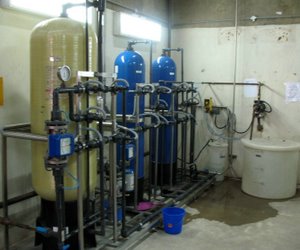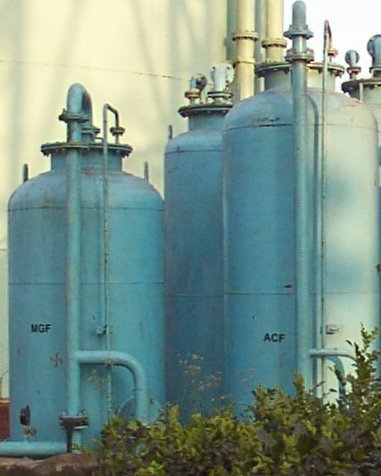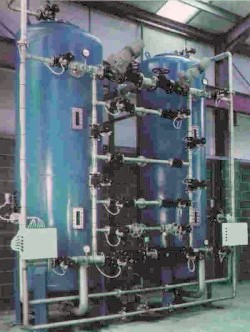Water softening systems
The hardness in water is caused by Calcium (Ca+) and Magnesium (Mg+) salts. These ions form hard, difficult to remove layer on surfaces of pipes and equipment in drinking water and process water systems and are normally known as scale in the water. This scale reduces the efficiency of the equipments and reduces the life of it too. This scale built-up increases fuel and maintenance costs.
Softening units offer a water purification solution for hard water and limescale removal.
| Softening Process | Regeneration | Water Quality | Applications | FRP Softening Units | Carbon Steel Softening Units |
Softening Process
Softeners are specific ion
exchangers which are designed to remove ions with a multiple positive
charge. A process in which Contaminant ions
are removed from water is called ion exchange. As the name implies, contaminant
ions are not merely removed from the water; instead, they are exchanged
for another kind of ion. This process occurs in ion exchange resin.
Initially, resin is loaded with Sodium
(Na+) ion. As water passes through the resin, the contaminant ions in the
water displace the loaded ions from the sites on the resin. This is because
the resin has a greater affinity for the contaminant ions. Affinity for
most resins is based loosely on ionic size and charge. In general, affinities
are as follows:
single charge ions (H+, Na+) < 2 charges (Ca++, Mg++) < 3 charges (Fe+++) < etc.
Water is passed through a column
filled with ion exchange resin. Water is discharged from the bottom of
the column with little or undetectable concentrations of hardness causing
ions.
Regeneration
Over a period of time most of the softener
resin gets converted into Ca, Mg form and it has no Sodium Ions (Na+) to
replace Ca, Mg ions. This is called the resin exhaustion or end of service
cycle. The exhausted resin has to be brought back into Sodium (Na+) form
to continue the process and use it again and again. The procedure of converting
exhausted resin into Sodium (Na+) form is called regeneration. Normal salt
is used for regeneration.
Water Quality
The hardness of treated water generally
we get after softener is less than 5 ppm as CaCO3, which is considered
as commercial zero.
We supply hardness test kit along with softener, as well as spare.
Applications
- Water for house-hold use
- Boiler Feed Water
- Process Water
- Laboratories
- Chemical Industries
- Pharmaceutical Industries
- Fertilizer Industries
- Textile Industries
- Food Processing Industries
- Breweries
- Electronic Industries
- Automobile Industries
And many more, where soft water is required
FRP Body with Multi-port valve Up-flow Softening Systems:
 Flow range - 2 m3/hour to 15 m3/hour.
Flow range - 2 m3/hour to 15 m3/hour.NON CORRODING VESSELS
Hrushikesh Water models made from glass fiber reinforced
polyester. Additional reinforcement from continuous woven over wrap.
SOFTENING MEDIA
High quality resin provides stability and uniform size
for top performance and long life. Treated water hardness = < 5 ppm
CaCO3
OPERATING LIMITS
| Pressure | 14 - 50 psi (1-3.5 kg/cm2) |
| Vacuum | None |
| Temperature | 1 - 40°C |
| Turbidity | 5 NTU, max. |
| Chlorine | 0.5 mg/l, max. |
| Iron | 5 mg/l |
| Electrical (For Automatic) | 220V AC, 50 HZ / 24 VDC |
-
Flow range - 7 m3/hour to 250 m3/hour.
HIGH QUALITY VESSELS
-
Hrushikesh Water models made from IS-2062 Grade Carbon
Steel with inside corrosion resistance epoxy coating and outside red-oxide
primer for long life operation. Vessels are build as per good engineering
practice. We can also build vessels as per ASME Sec. VIII, Div.-I and IS-2825,
if it is your requirement.
SOFTENING MEDIA
OPERATING LIMITS
| Pressure | 14 - 100 psi (1-7 kg/cm2) |
| Vacuum | None |
| Temperature | 1 - 50°C |
| Turbidity | 2 NTU, max |
| Electrical (For Automatic) | 220V AC, 50 HZ / 24 VDC |








